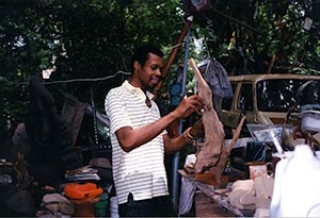Born 1950, Birmingham, Alabama
Lonnie Holley paints, carves in sandstone, and assembles cast-off objects into sculpture, such that the contemplative bent of his work renders him as much a diviner as an artist. In some cases Holley is struck by the language of objects around him. Protecting Myself the Best I Can (Weapons by the Door) was a remnant of one woman’s effort to defend herself, which Holley discovered after she had moved away. In other instances Holley’s arrangements are poignant meditations on “what we as humans have to deal with,” whether knowing how to wield power, finding equilibrium among life’s tumults, or confronting larger-than-life forces—as seen in the haunting composition of found metal, bone, and dried flowers in The Boneheaded Serpent at the Cross (It Wasn’t Luck).[1] Often, the found objects suggest themes for the artist, who manipulates them through an improvisational, dialogic process that seeks spiritual insight in the material world.
Holley’s first artwork was a small tombstone carved in 1979 for his deceased nieces, an object created in the wake of difficult years in foster homes, working as a migrant, and caring for impoverished family members. Art became integral to setting his life on another path. He eventually filled his one-acre property near Birmingham, Alabama, with visionary sculptures. Around 1986 or 1987 Holley met William Arnett, a curator and patron who would become Holley’s staunchest advocate. Due in large part to Arnett’s research, collecting, and preservation efforts, Holley found his practice not only validated and invigorated but given a burgeoning place in art history. Arnett’s monumental 1996 exhibition, Souls Grown Deep: African American Vernacular Art of the South, and subsequent publication demonstrated the vitality and rootedness of Afro-Atlantic aesthetic and spiritual practices in this region of the US—and by extension challenged the contemporary art world to expand its boundaries.
Holley’s art environment was destroyed in 1997 after a protracted legal battle with the Birmingham Airport Authority, whose expansion plans infringed upon the artist’s property lines. In 2010, following a period in Harpersville, Holley moved to Atlanta, where he continues to work today. In addition to developing experimental music, he has crossed seamlessly into the mainstream visual art world, with works in the collections of the Whitney Museum of American Art and the Metropolitan Museum of Art in New York.
Elaine Yau
[1] “Lonnie Holley—Sculpture Making at ATP Curated by Deerhunter Part 1 of 2,” www.youtube.com/watch?v=MqnLeu7KQYo (accessed September 23, 2016).
Arnett, William, and Paul Arnett, eds. Souls Grown Deep: African-American Vernacular Art of the South. 2 vols. Atlanta: Tinwood Books, 1999 and 2001.
McWillie, Judith. “Lonnie Holley’s Moves.” Artforum 30, no. 8 (April 1992): 80–84.
